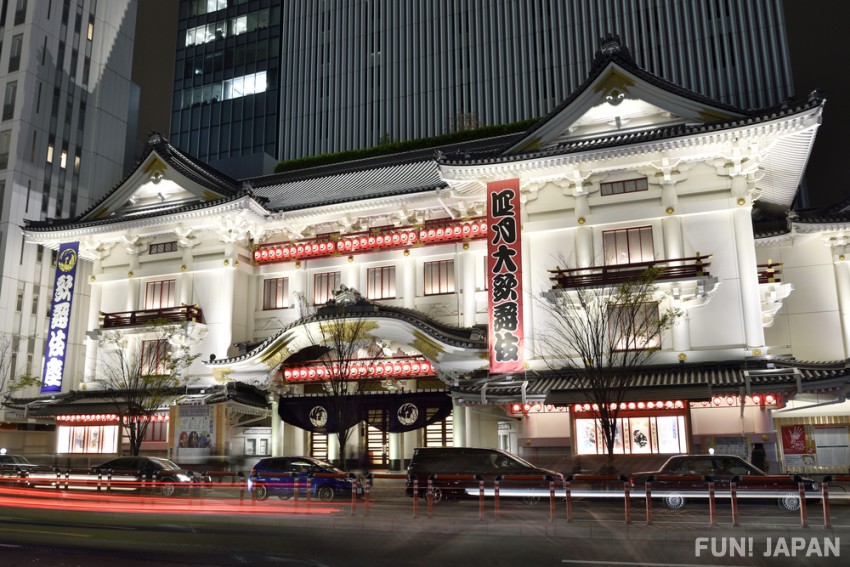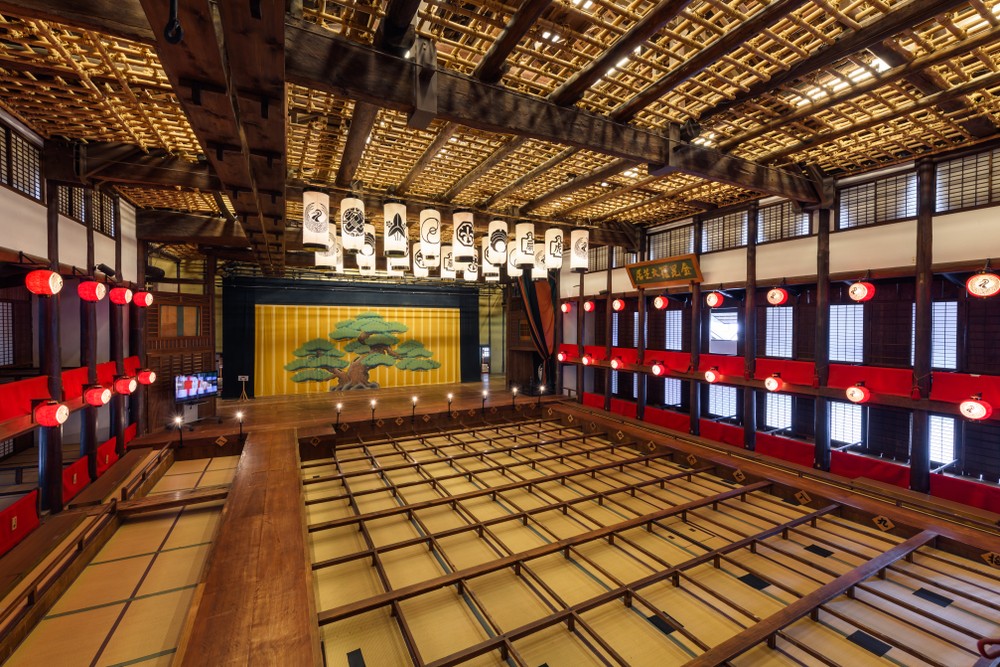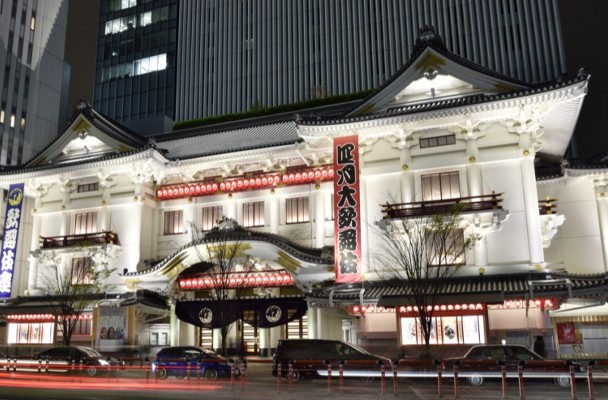
Have you ever wanted to go and see a kabuki play, but aren't really sure what kind of place the theatre is? Maybe you have an interest in more classical theatres as well as modern ones? It's for people with doubts such as these that we have made this article! There are many different layouts and mechanics to kabuki theater and its stage, let's take a look into some of the differences and unique aspects together.
Modern Kabuki Theatres
First and foremost, let's take a look into modern kabuki theatres. We're going to introduce the Kabuki-za Theatre in Higashi-Ginza. Let's list out what kind of facilities the theatre has from the ground up.
The second basement level is directly connected to the Tokyo Metro Hibiya Line and Toei Asakusa Line Higashi-Ginza Station making it extremely easy to access.
Within the second basement level, you'll find a ticket counter, restaurants, souvenir stores, bento box stores, and stores selling food and miscellaneous goods.
On the first basement level, you'll find a coin locker and toilets. There are many toilets available, which are very useful for women.
Once you reach the first floor, you'll reach the theatre's lobby. Within the lobby, there is an information desk, stores that sell synopsis' of the plays, toilets, a drink corner, and a rental corner for earphones and subtitle guides.
On the first floor of the theatre you'll find 897 seats, and 441 on the second, all of which come equipped with a subtitled guide device where you can place your rented subtitle guide and enjoy the show hands-free. In the event that you're in one of the front row seats of the 3rd floor, you have to hold the device yourself.
The subtitle guide comes not only in Japanese but also with simple English explanations for the lines of dialogue and more to help non-japanese speakers to understand the plays.
On the first floor lobby, you'll also find the Hinoki Cafe where you can enjoy a coffee or cake during the play's intermission period. We highly recommend the yatsuhashi (cinnamon-seasoned rice flour cracknel) which appears in kagotsurube satono eizame.
On the 2nd floor, you'll find guest seating, the restaurant Ootori, a drink corner, and toilets. You're able to easily see the entire stage from the 2nd floor.
The 3rd floor also has guest seating, an information desk, the restaurant Hanakago, a drink corner, coin lockers, kiosks, a smoking area, and toilets. At Hanakago, you're able to buy lunchboxes to eat during the performances, as well as even sushi! You're also able to see the entire stage from a higher perspective from the 3rd floor.
The 4th floor has seats that allow you to enjoy a single show. All seats here are first-come-first-serve, with tickets needing to be purchased on the day of the play. These seats total 150 with 90 being seated and 60 being standing. However, when the play in question has aerial stunts, seating availability here may be limited.
After purchasing your ticket for the single play on the left side of the ticket counter after entering the theatre, you can use the special elevator behind the ticket counter to reach the 4th floor. These tickets are very popular with people that just want a taste of what kabuki theatre has to offer, and we highly recommend getting to the theatre early if this is something you may be interested in.
A Kabuki Theatre Stage's Many Contraptions!
It's time to look into some of the contraptions and intricacies of the kabuki stage to allow you to enjoy the plays you're watching even more. There are many different contraptions used on a kabuki stage to allow for more interesting and dynamic performances. It's almost like a modern-day amusement park attraction.
Try and remember some of the following information when you're next looking at a kabuki theatre stage.
There are separate names for people viewing the stage from different angles, the right side is known as "kamite" and the left side is known as "shimote". During the performance, characters of high praise and standard will appear from higher positions, while people of lower standing will appear from lower positions. The stage setting is skillfully created so that there is an indoor and outdoor setting. The direction of everything is set beforehand, with the upper part being to the east, and lower to the west, while the guest seating is to the south.
One of the extremely interesting and fun things to experience within kabuki theatre is known as "hayagawari" where a character changes their appearance extremely quickly during the performance. Once contraption used during this is known as a "mawari butai" or "revolving stage".
This, as the name suggests, is a circular part on the stage that is able to spin. It was said to have begun in the Edo Period of Japan and then eventually gained enough popularity to be used within foreign theatres during the Meiji period of Japan also.
Using the spinning stage to move around actors or items used within the play is known as "seri" in Japanese. In Kabuki-za there are 5 different "seri" known as "Matsuzeri", "Takezeri", "Umezeri", "Daizeri", and "Suppon".
The "hanamichi" which goes through the lower guest seating is approximately 18.18 meters long. This is the exact same as the radius of the revolving stage.
The stage and hanamichi are referred to as "Naraku". These are where the contraptions used for things such as the revolving stage or seri are placed.
There is also a small room where various instruments such as drums and bells are placed to create sound effects during the performance, these sound effects or music are known as "nagauta", and the room as "kuromisu".
The painting which is displayed in front of the kuromisu is known as the "daijin kakoi" and can be flipped to display different images, with the scenery change referred to as "Aori". The aori is typically turned from the exterior of the stage to the interior through manpower.
Japan's Oldest Shibaigoya (Theatre)
While Kabuki-za in Tokyo boasts some of the latest and greatest in kabuki theatre techniques, there is also Japan's oldest shibaigoya, the "Konpira Grand Theatre".
Kotohiragu is a place where the common people would come to pray. 3 times a year within the town originally built around a temple or shrine Kotohira, theatres and sumo events would take place. While these typically took place in temporary establishments, this theatre was created to allow for a location for all future plays.
The first and second floor has guest seating, a hanamichi, a rotating stage, a dressing room, and a karaido. The karaido refers to the joint connecting the stage to the hanamichi (a 4-way 90-centimeter beam). This beam also goes through the dressing room underneath the stage and is often made to look like a well or pond so that the actors can come and go from the stage quickly. Karaido are typically not seen in modern-day theaters.

Some of Japan's Largest Kabuki Theatres
There are many theatres throughout Japan where you can watch kabuki theatre. Some of which have state-of-the-art facilities while others are similar to the Konpira Grand Theatre and have older contraptions in them, either is fun to visit. Kyoto's Kyōto Shijo Minami-za is especially recommended for its classical feel.
Tokyo
National Theatre of Japan
- Name: National Theatre of Japan
- Access: 5-minute walk from Hanzomon Station using the Tokyo-Metro Hanzomon Line / 15-minute walk from JR Yotsuya Station
- Address:4-1 Hayabusacho, Chiyoda City, Tokyo 102-8656
- Performance Timings: 要確認
- Fee:要確認
Kabuki-za Theatre
- Name: Kabuki-za Theatre
- Access:Tokyo Metro Hibiya Line / Toei Asakusa Line Higashi-ginza Sta. Entrance 3
- Address:4 Chome-12-15 Ginza, Chuo City, Tokyo 104-0061
- Performance Timings: 要確認
- Fee:要確認
Shinbashi Enbujo
- Name:Shinbashi Enbujo
- Access:6-minute walk from Tokyo Metro Hibiya Line / Toei Asakusa Line Higashi-ginza Sta. Entrance 6 / 3-minute walk from Toei Ōedo Line Tsukijishijo Sta. A3 Entrance
- Address:6 Chome-18-2 Ginza, Chuo City, Tokyo 104-0061
- Performance Timings: 要確認
- Fee:要確認
Misono-za
- Name: Misono-za
- Access:2-minute walk from Nagoya City Subway-Higashiyama Line / Nagoya City Subway-Tsurumai Line Fushimi Station Entrance 6
- Address:1 Chome-6-14 Sakae, Naka Ward, Nagoya, Aichi 460-8403
- Performance Timings:要確認
- Fee:要確認
Osaka
Osaka Shochikuza Theatre
- Name: Osaka Shochikuza Theatre
- Access:1-minute walk from Osaka Metro Midosuji Line / Osaka Metro Yotsubashi Line / Osaka Metro Sennichimae Line Namba Station Entrance 14
- Address:1 Chome-9-19 Dotonbori, Chuo Ward, Osaka, 542-0071
- Performance Timings: 要確認
- Fee:要確認
Kyoto
Kyōto Shijo Minami-za
- Name:Kyōto Shijo Minami-za
- Access:3-minute walk from Hankyu Kyoto-Kawaramachi Station Entrance 1 / Close to Keihan Electric Railway Gion-Shijō Station Entrance 6
- Address:〒605-0075 Kyoto, Higashiyama Ward, Nakanocho, 198 Shijo-Ohashi Bridge East
- Performance Timings:要確認
- Fee:要確認
Kagawa
Konpira Grand Theatre
- Name: Konpira Grand Theatre
- Access:40 minutes via car from Takamatsu Airport / 20 minute-walk from JR Kotohira Station
- Address:〒766-0001 Kagawa, Nakatado District, Kotohira
- Performance Timings:要確認
- Fee:要確認
Fukuoka
Hakataza Theater
- Name:Hakataza Theater
- Access:Connected to Exit 7 of the Nakasukawabata Station
- Address:2-1 Shimokawabatamachi, Hakata Ward, Fukuoka, 812-0027
- Performance Timings:要確認
- Fee:要確認

Comments